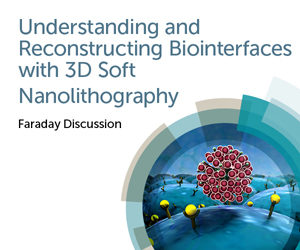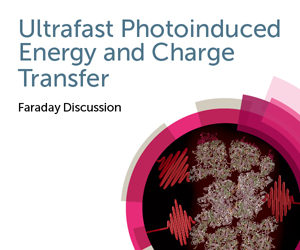 We are delighted to share with you a selection of the Accepted Manuscripts that will be discussed at the upcoming Faraday Discussions meeting on hot-electron science and microscopic processes in plasmonics and catalysis.
We are delighted to share with you a selection of the Accepted Manuscripts that will be discussed at the upcoming Faraday Discussions meeting on hot-electron science and microscopic processes in plasmonics and catalysis.
We very much hope you enjoy reading the articles and that you will join us to present your own research poster to leading scientists including Jeremy Baumberg, Naomi Halas, Javier Aizpurua, Alexandra Boltasseva and many more.
Submit a poster abstract by 10 December
Read this selection of Accepted Manuscripts which will be presented in London:
Direct optical excitation of dark plasmons for hot electron generation
Niclas A Müller, Bruno G. M. Vieira, Dominik Höing, Florian Schulz, Eduardo Bedê Barros, Holger Lange and stephanie Reich
Enhanced hot electron generation by inverse metal–oxide interfaces on catalytic nanodiode
Hyosun Lee, Sinmyung Yoon, Jinwoung Jo, Beomjoon Jeon, Taeghwan Hyeon, Kwangjin An and Jeong Y. Park
The role of a plasmonic substrate on the enhancement and spatial resolution of tip-enhanced Raman scattering
Mahfujur Rahaman, Alexander G. Milekhin, Ashutosh Mukherjee, E E Rodyakina, Alexander Latyshev, Volodymyr Dzhagan and Dietrich RT Zahn
Assistance of metal nanoparticles to photo-catalysis – nothing more than a classical heat source
Yonatan Sivan, Ieng Wai Un and Yoni Dubi
Out-of-equilibrium electron dynamics of silver driven by ultrafast electromagnetic fields – a novel hydrodynamical approach
Andrea Marini, Alessandro Ciattoni and Claudio Conti
Electron-induced molecular dissociation at a surface leads to reactive collisions at selected impact parameters
John C Polanyi, Kelvin Anggara, Lydie Leung, Matthew J Timm and Hu Zhixin
Generation of hot electrons in nanostructures incorporating conventional and unconventional plasmonic materials
Tianji Liu, Lucas V. Besteiro, Zhiming Wang and Alexander O. Govorov
Impact of chemical interface damping on surface plasmon dephasing
Andrew J. Therrien, Matthew J. Kale, Lin Yuan, Chao Zhang, Naomi J Halas and Phillip Christopher
Monitoring plasmonic hot-carrier chemical reactions at the single particle level
Sabrina Simoncelli, Evangelina Pensa, Thomas Brick, Julian Gargiulo, Alberto Lauri, Javier Cambiasso, Yi Li, Stefan A. Maier and Emiliano Cortes












 .
. We’ll be discussing some of the latest developments in nanolithography of biointerfaces at our
We’ll be discussing some of the latest developments in nanolithography of biointerfaces at our  We are delighted to announce that the latest volume of Faraday Discussions on
We are delighted to announce that the latest volume of Faraday Discussions on 



 We are delighted to share this collection of the most read articles from last year’s diverse range of Faraday Discussions. From fundamental studies to applied research, these articles showcase the breadth of topics being discussed by world renowned researchers, with many available
We are delighted to share this collection of the most read articles from last year’s diverse range of Faraday Discussions. From fundamental studies to applied research, these articles showcase the breadth of topics being discussed by world renowned researchers, with many available 